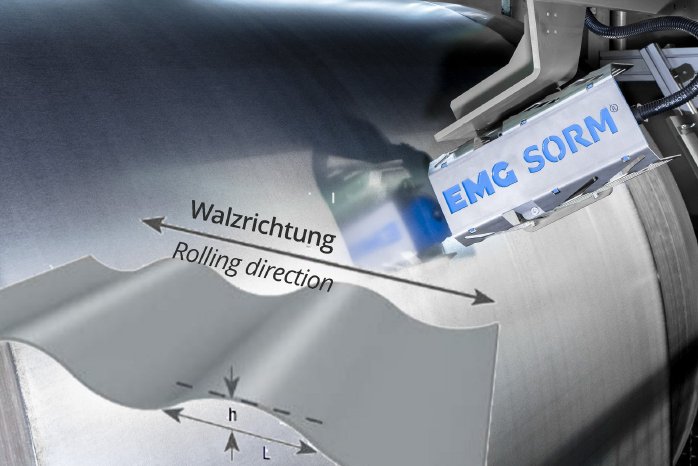Waviness refers to the longer wavelength components of the surface texture compared to the roughness. More precisely, it is defined as irregularities in the form of wavy or undulating patterns, the distance of which is greater than the roughness measurement distance (wavelengths starting from about 0.5 mm up to 10 mm or more). Traditionally, waviness is measured using form testers or contour measuring devices that scan larger areas of the surface. This includes both stylus-based contact instruments as well as optical & laser-based non-contact instruments. EMG SORM® belongs to the group of optical measurement devices with online capability and goes far beyond laboratory measurements.
High waviness in automotive sheet steel presents significant challenges in both production and final application. Primarily, it can lead to poor paint quality due to uneven application, resulting in aesthetically unpleasing finishes and compromised corrosion resistance. In addition, waviness affects the adhesion of critical coatings such as adhesives and sealants, which can lead to delamination and reduced effectiveness, affecting the durability and integrity of the vehicle. From a structural perspective, excessive waviness can alter stress distribution, increasing the risk of fatigue failure in cyclically stressed components, which is a significant concern for parts such as body panels and structural frameworks.
To summarise, excessive waviness significantly impairs the dimensional accuracy, surface quality, rigidity and workability of the sheets. This can lead to assembly problems, quality defects and higher material usage. Low waviness is therefore very important for the automotive industry and effective control of waviness is therefore critical not only to meeting aesthetic and functional standards, but also to ensure manufacturing reliability and performance integrity of the final automotive product.
EMG SORM®
The new generation of EMG SORM® is based on the confocal chromatic measurement principle and is suitable for both roughness and waviness measurements. This method utilises the effect that lenses have different focal points for different wavelengths of light. This feature provides a very accurate, fast, non-contact distance measurement that can be used to generate a surface profile. Based on this, EMG SORM® calculates the roughness values defined in DIN EN 10049 and the waviness parameters specified in test sheet SEP 1941, including the arithmetic mean roughness value Ra, the peak count value RPc and the waviness value Was. The maximum line speed for Ra and Wsa measurement is 350 m/min. An LED light source in the visible spectrum is used. Overall, EMG SORM® employs a well understood technology that is already used for roughness measurement in laboratories. There are no special safety requirements when operating the system - for example in comparison to the use of laser measurement methods.
Thanks to the physical principle applied, EMG SORM® provides reliable roughness and waviness data over the strip length and width and can be used for all different surface structures (EBT, EDT, LBT, SBT, PRETEX®, ...) without special adaptation. Due to the very small installation dimensions (less than 400 mm in production direction) and a measuring distance of 25 mm, the system can be easily and safely integrated into the line.
Conclusion
In conclusion, managing waviness in automotive sheet steel is crucial for ensuring optimal surface quality, structural integrity, and overall performance of automotive components. The new generation of EMG SORM® offers a sophisticated, reliable, and efficient solution for both roughness and waviness measurement, leveraging the confocal chromatic measurement principle. With its non-contact measurement at production speed and easy integration, EMG SORM® is an indispensable tool for meeting the stringent standards of the automotive industry.
More info?
For deeper insights and detailed product information, please contact EMG Metals. Our sales and service as well as our product management are ready to assist you in enhancing your manufacturing processes and achieving superior product quality.
Download Brochure: EMG SORM® Brochure


